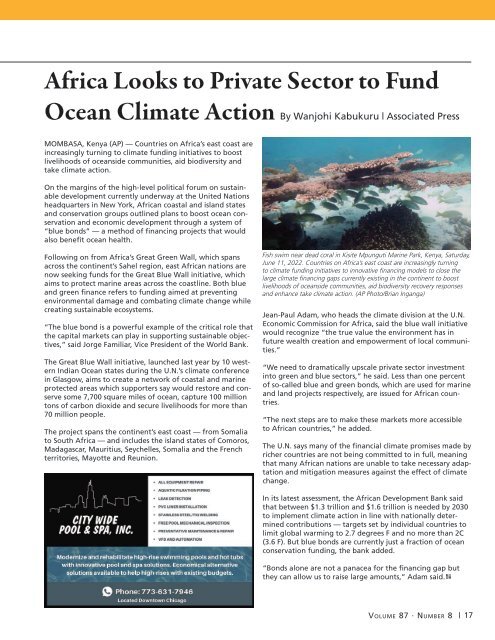CEAC-2022-08-August
Create successful ePaper yourself
Turn your PDF publications into a flip-book with our unique Google optimized e-Paper software.
Africa Looks to Private Sector to Fund<br />
Ocean Climate Action By Wanjohi Kabukuru | Associated Press<br />
MOMBASA, Kenya (AP) — Countries on Africa’s east coast are<br />
increasingly turning to climate funding initiatives to boost<br />
livelihoods of oceanside communities, aid biodiversity and<br />
take climate action.<br />
On the margins of the high-level political forum on sustainable<br />
development currently underway at the United Nations<br />
headquarters in New York, African coastal and island states<br />
and conservation groups outlined plans to boost ocean conservation<br />
and economic development through a system of<br />
“blue bonds” — a method of financing projects that would<br />
also benefit ocean health.<br />
Following on from Africa’s Great Green Wall, which spans<br />
across the continent’s Sahel region, east African nations are<br />
now seeking funds for the Great Blue Wall initiative, which<br />
aims to protect marine areas across the coastline. Both blue<br />
and green finance refers to funding aimed at preventing<br />
environmental damage and combating climate change while<br />
creating sustainable ecosystems.<br />
“The blue bond is a powerful example of the critical role that<br />
the capital markets can play in supporting sustainable objectives,”<br />
said Jorge Familiar, Vice President of the World Bank.<br />
The Great Blue Wall initiative, launched last year by 10 western<br />
Indian Ocean states during the U.N.’s climate conference<br />
in Glasgow, aims to create a network of coastal and marine<br />
protected areas which supporters say would restore and conserve<br />
some 7,700 square miles of ocean, capture 100 million<br />
tons of carbon dioxide and secure livelihoods for more than<br />
70 million people.<br />
The project spans the continent’s east coast — from Somalia<br />
to South Africa — and includes the island states of Comoros,<br />
Madagascar, Mauritius, Seychelles, Somalia and the French<br />
territories, Mayotte and Reunion.<br />
Fish swim near dead coral in Kisite Mpunguti Marine Park, Kenya, Saturday,<br />
June 11, <strong>2022</strong>. Countries on Africa’s east coast are increasingly turning<br />
to climate funding initiatives to innovative financing models to close the<br />
large climate financing gaps currently existing in the continent to boost<br />
livelihoods of oceanside communities, aid biodiversity recovery responses<br />
and enhance take climate action. (AP Photo/Brian Inganga)<br />
Jean-Paul Adam, who heads the climate division at the U.N.<br />
Economic Commission for Africa, said the blue wall initiative<br />
would recognize “the true value the environment has in<br />
future wealth creation and empowerment of local communities.”<br />
“We need to dramatically upscale private sector investment<br />
into green and blue sectors,” he said. Less than one percent<br />
of so-called blue and green bonds, which are used for marine<br />
and land projects respectively, are issued for African countries.<br />
“The next steps are to make these markets more accessible<br />
to African countries,” he added.<br />
The U.N. says many of the financial climate promises made by<br />
richer countries are not being committed to in full, meaning<br />
that many African nations are unable to take necessary adaptation<br />
and mitigation measures against the effect of climate<br />
change.<br />
In its latest assessment, the African Development Bank said<br />
that between $1.3 trillion and $1.6 trillion is needed by 2030<br />
to implement climate action in line with nationally determined<br />
contributions — targets set by individual countries to<br />
limit global warming to 2.7 degrees F and no more than 2C<br />
(3.6 F). But blue bonds are currently just a fraction of ocean<br />
conservation funding, the bank added.<br />
“Bonds alone are not a panacea for the financing gap but<br />
they can allow us to raise large amounts,” Adam said.<br />
Volume 87 · Number 8 | 17

















